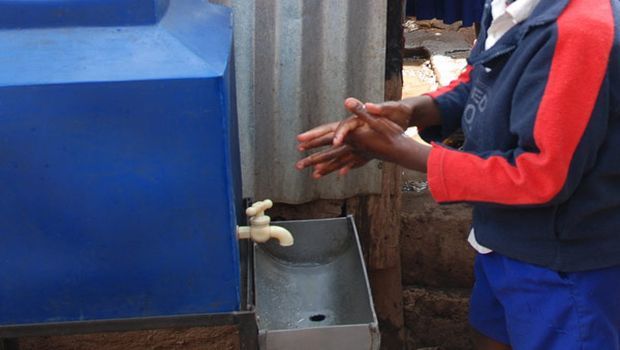Stanford Researchers Use Video to Better Understand Handwashing Behavior
One of the best defenses against infectious disease is one of the most simple – handwashing. Still, despite years of global public awareness campaigns, handwashing rates remain low. Caregivers of young children in low-income, developing world settings are found to wash their hands only 17 percent of the time after using the toilet.


Observing handwashing behaviors. Photo by Amy Pickering/Stanford
One of the best defenses against infectious disease is one of the most simple – handwashing. Still, despite years of global public awareness campaigns, handwashing rates remain low. Caregivers of young children in low-income, developing world settings are found to wash their hands only 17 percent of the time after using the toilet.
A new study finds that video surveillance can provide insights into hand washing behavior. When another person is present, for example, handwashing rates increase 23 percent. These findings could, in turn, inform the design, monitoring and evaluation of hygiene campaigns.
"Hopefully, video surveillance will be added to the toolbox for accurately measuring hand hygiene behavior, thus improving monitoring and evaluation of interventions around the world," says Amy Pickering, the study's lead author and a research associate at the Stanford Woods Institute for the Environment.
Co-author Jenna Davis, a senior fellow at Woods, adds, "Handwashing is notoriously difficult to study. Video surveillance looks to be a promising strategy for obtaining reliable information, even in resource-constrained settings."
The study, published in the journal PLOS One, was carried out using video cameras installed in the washing areas outside latrines of four public schools in the sprawling Kibera slum of Nairobi, Kenya. Parents and administrators gave permission for the study, and teachers were informed in advance.
Pickering acknowledged that the students' awareness of the cameras – teachers alerted them – likely affected their behavior. Still, Pickering pointed to the study's findings as valuable data showing advantages of video surveillance over in-person observation.
Those advantages include lower cost, less time commitment and faster, more reliable data processing. Having two research assistants watch video and record data is possible with in-person observation, but would add significant cost and logistical complications, while likely influencing hand washers' behavior to an even greater extent.
Among the study's findings:
- Both methods of observation found the hand cleaning rate after toileting was higher among girls – a 4 percent difference, according to video surveillance, and a 3 percent difference, according to in-person observation.
- Both video observation and in-person observation demonstrated longer hand cleaning times for hand washing with soap as compared to rubbing with sanitizer.
- Students at schools equipped with soap and water, instead of sanitizer, were 1.3 times more likely to wash their hands during simultaneous video surveillance and in-person observation when compared with periods of in-person observation alone.
- Overall, when students were alone at a hand cleaning station, hand cleaning rates averaged 48 percent, compared to 71 percent when at least one other student was present.
- Hand-cleaning rates showed an overall trend of increasing as the number of other people present at hand-cleaning stations increased, with the exception of a slight decrease in hand-cleaning when more than 10 people were observed.
Based on the findings, the authors suggest the following strategies for better hygiene:
•Placement of hand cleaning materials in public locations
•Scheduling specific times for bathroom breaks between classes
•Designating specific students to be hand hygiene "champions"
•Formation of student clubs to demonstrate and promote hand hygiene to classmates
Source: Stanford Woods Institute for the Environment
The Guardians of Animal Health: Who Are Veterinary Infection Preventionists?
March 21st 2025Veterinary infection control experts Leslie Kollmann, BS, AAS, CVT, CIC, Denise Waiting, LVT, and Leslie Landis, LVT, BS, discuss challenges, zoonotic disease risks, and the importance of education, collaboration, and resource development in animal care facilities.
The Latest on CLABSIs and CAUTIs: Evidence-Based Approaches for Infection Prevention
February 27th 2025Health care–associated infections like CLABSIs and CAUTIs threaten patient safety. Learn evidence-based strategies, new technologies, and prevention protocols to reduce these infections and improve outcomes.
Resilience and Innovation: The Pivotal Contributions of Black Americans to Health Care and Medicine
February 24th 2025During Black History Month, we honor the resilience and contributions of Black medical professionals in health care. Despite barriers, they have led transformative changes, advocating for equitable access and medical excellence. Recognizing their impact ensures a more inclusive health care future for all.
Glove Usage Guideline: From The Joint Commission, CDC, and World Health Organization
February 17th 2025Proper glove use is crucial in health care settings to prevent infections. Guidelines from TJC, CDC, and WHO stress correct selection, usage, and disposal to minimize health care–associated infections (HAIs) and cross-contamination risks. Infection preventionists (IPs) play a key role in educating staff, enforcing compliance, and improving patient safety through standardized glove practices.